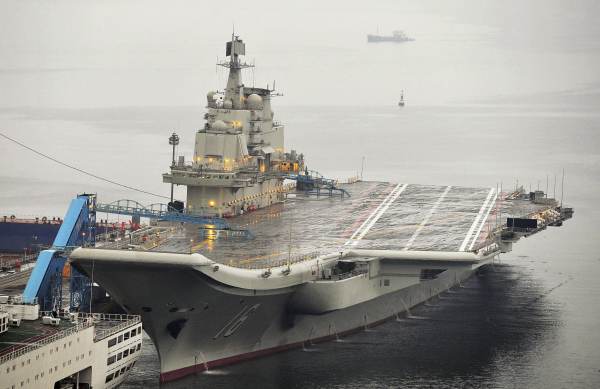China has conducted the first landing of a fighter jet on its new aircraft carrier in a move that extends Beijing’s ability to project its growing military might in territorial disputes.
The Chinese-made J-15 made the successful landing on the Liaoning, a former Soviet carrier, during recent exercises, the defence ministry said in a report Sunday on the flight tests.
The Liaoning went into service in September in a symbolic milestone for China’s growing military muscle that comes at a time when Beijing is increasingly embroiled in a series of territorial disputes with its neighbours.
“The successful landing… has always been seen as a symbol of the operating combat capability for an aircraft carrier,” Zhang Junshe, a vice director at the military’s Naval Affairs Research Institute, told state television.
“This is a landmark event for China’s aircraft carrier… and (moves it) one step closer to combat readiness.”
Video carried by China Central Television showed a tail hook on the rear of the J-15 catching hold of a cable on the deck of the aircraft carrier as the jet landed and slowed to a halt.
China had not previously announced that its navy possessed such highly technical cable landing technology.
The J-15 had also successfully taken off from the aircraft, the ministry said.
The J-15 is a Chinese designed multi-purpose carrier-borne fighter jet based on Russia’s Sukoi 33, equipped with Russian engines and capable of carrying precision-guided bombs, press reports said.
Since the carrier entered service, the crew have completed more than 100 training and test programmes, the ministry said.
China bought the stripped-down 300-metre (990-foot) carrier from Ukraine nearly 10 years ago and refurbished it at the northeastern port of Dalian.
Construction of the vessel, formerly known as the Varyag, was commissioned by the former Soviet Union more than 20 years ago, but work halted with the sudden collapse of the Soviet bloc.
The Liaoning — named for the northeastern province which includes Dalian — is not expected to be fully operational for another three years at least.
Over the past year, China has become increasingly assertive over its longtime maritime territorial claims as its economic and military power have expanded, causing rising anxiety among its neighbours.
Tensions in the East China Sea have risen dramatically in recent months over islands known as the Diaoyus to Beijing and claimed by Tokyo as the Senkakus.
China is locked in a similar row with Vietnam and the Philippines in the South China Sea.
At a key Communist Party congress earlier this month, outgoing President Hu Jintao urged the nation to push forward fast-paced military modernisation and set the goal of becoming a “maritime power”.
Such an endeavour would mean that China would soon need to construct an independently built aircraft carrier, Hu Wenming, chairman of China State Shipbuilding Corp (CSSC) that retro-fitted the Liaoning, said.
“We must enhance our independent weapons and equipment research and production capacity to match the country’s clout, and independently build our own aircraft carriers,” Hu told the China Daily on the sidelines of the congress.
A top Taiwan intelligence official said earlier this year that China had already decided to build two aircraft carriers. However despite rumours that work has already begun, there is no evidence has started.











